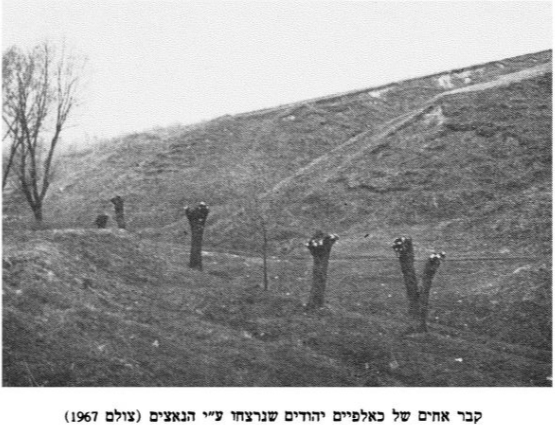On September 3, 1942, between 1,500 and 2,000 Jews, mostly the elderly, women, and children, were executed outside the Jewish cemetery.
Although survivors of the town eventually erected a monument in the general area of the killings, still until today, those and others killed later during the war, rest in unmarked mass graves.

The Background
The Deportation of September 2-3, 1942
On September 3rd, 1942, the Nazi’s completed an Aktion in the city of Dzialoszcye, Poland. Jews were told to walk to the train station to be resettled. The Germans offered wagon rides to those who could not walk. About 50 wagons containing mostly the elderly, women, and children were used to transport between 1,200-2,000 Jews. However, instead of going toward the train station, the wagons drove to a ravine just outside the Jewish cemetery. Upon disembarking, the Jews were forced to strip and hand over their belongings and were executed. In 1992, survivors established a monument in the general area. However, until today, the exact boundaries of the mass grave(s) remain unmarked.
Testimony
Dr. Moshe Byjski - Dzialoszyce Yizkor Book -https://www.jewishgen.org/yizkor/dzialoszyce/dzi233.html
After some time, many carts harnessed to horses, with farmers serving as the drivers, started arriving in the area. The Germans and men of the Ordnungsdienst walked through the rows of standing people and announced that all those for whom walking to the train station some distance away would be difficult should climb onto the carts and be transported there. Very many women and elderly were persuaded to climb on. They did this in the hope that they would save themselves the effort of walking while their meager possessions were on their backs. The row of carts started on its way—but we immediately observed that something was not as it should be; instead of leaving the market square in the direction of Kościuszko Street that led to the train station, the carts continued going straight down Skalbmierska Street, the street that led to the cemetery.
In the meantime, the market square had become full of people. We were ordered to march in the direction of the train station while the SS armed officers escorted us. While we were underway, we heard machinegun fire shooting non-stop. Our thoughts were with all those people who had traveled on the carts. This machinegun shooting was probably aimed at them. After some time, when I returned to the town after having escaped from a camp, it became clear that this was indeed the truth. Three huge mass graves were visible in the cemetery in which were buried all those who had been shot and murdered—which, to my anguish, included all the elderly and the women who had traveled on those carts. We will never ever know the exact numbers of the murdered victims. The estimates are between 1,200–2,000 holy martyrs.

